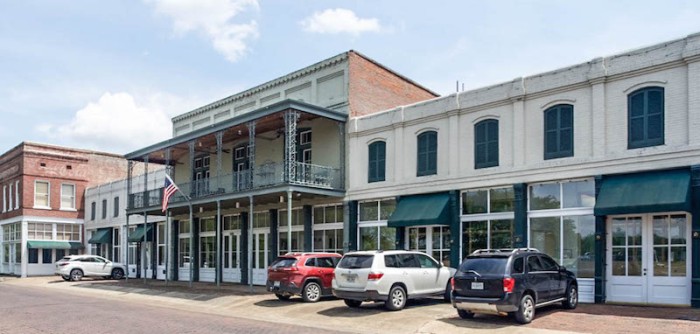
Readers know I have this love & admiration thing with iron columns, pilasters, and other iron architectural elements. I spotted a few new-to-me designs in Greenwood, and wanted to continue the focus on that town’s historic architecture. There are 16 iron pilasters and/or supports on the buildings above, for example, not counting the supports on the balcony.
Scherpe & Koken were proprietors of the Enterprise Architectural and Ornamental Iron Works & Foundry of St. Louis, MO. In an 1887 catalogue, Scherpe & Koken were at South 8th, Park Avenue, and Barry Street. You can download a copy of the catalogue for free, and it has beautiful illustrations of the available designs. In 1891, they were located on Old Manchester Road and Chouteau Avenue. Koken apparently bought out Scherpe as an 1894 article indicated that Scherpe, recently the senior member of Scherpe & Koken, was arrested on complaint by his wife that he was insane. However, the examining physician ruled no evidence of unsound mind. On November 21, 1894, John Frederick Scherpe killed himself in his office. He had been living with his sister, estranged from his family, for around three months, since the arrest. William T. Koken died in 1901 while bowling. He was 50.
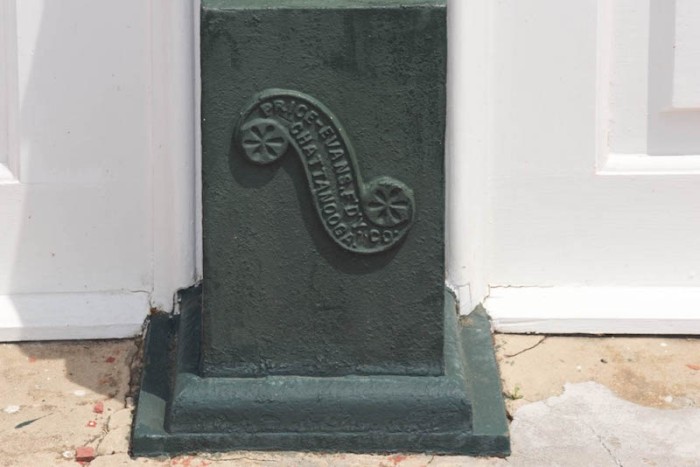
Price-Evans Foundry Company pillaster located 113 Howard Street; c. 1900
The Price-Evans Foundry Company operated out of Chattanooga, Tennessee. I did not find much about the company online or in the newspapers. The earliest mention I located was 1890, with others in 1901, 1917, and into the 1920s. The Iron Tradesman, August 1917 issue featured an advertisement for “architectural castings, structural steel, elevator enclosures, stairways, fire escapes, wire work, and All Kinds of Builders’ Iron Work.”
Over a hundred years later, we might not think about the dangerous work that was involved in producing these beautiful and structurally important elements. One of the few items I found on Price-Evans was in the story of Roland Hayes: The Legacy of an American Tenor, by C. A. Brooks and R. Sims. Hayes as a 14-year old African American boy who went to work for Price-Evans in 1901 for 80 cents a day. He worked with an adult man, loading iron from the freight yard and then assisted in the melting and molding to create iron door and window weights. Young Hayes wore brass-tipped brogans without shoestrings so that he could kick off his shoes easily if molten iron was spilled. His feet and legs had permanent scars from being hit by hot iron flakes. A couple of years later while he was working for the Casey-Hedges foundry, his clothes became entangled in the conveyer machine belt and he was pulled into the machinery and pulled through it three times before it could be stopped. Amazingly, he lived, and was sent home in a full-body-cast where he required ten weeks to recover.
I confess this column stumped me, and it took over six painstaking hours to ferret it out. Sometimes when you are just snapping photos, you miss details at the moment. This is a great example for paying more attention. When I got ready to identify this column’s origins, imagine my surprise when no letters seemed to make sense. Finally, I realized the column words seemed backwards, and ultimately, realized it was installed upside down. Because it has been painted ??? years, it took quite a while to decipher the column was from the Chickasaw Iron Works of our neighbor, Memphis, Tennessee.
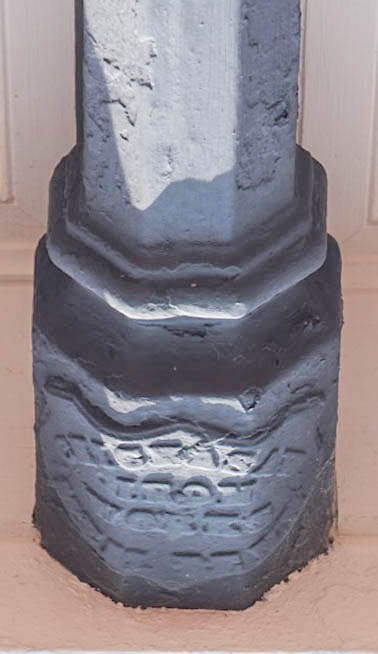
Chickasaw Iron Works–what seems obvious now was not looking at the original photograph.
I mentioned on the Bank of Greenwood post that I had spotted Christopher & Simpson iron work on one other building in town. I learned later that it was the “new” Bank of Greenwood building on Market and Howard.
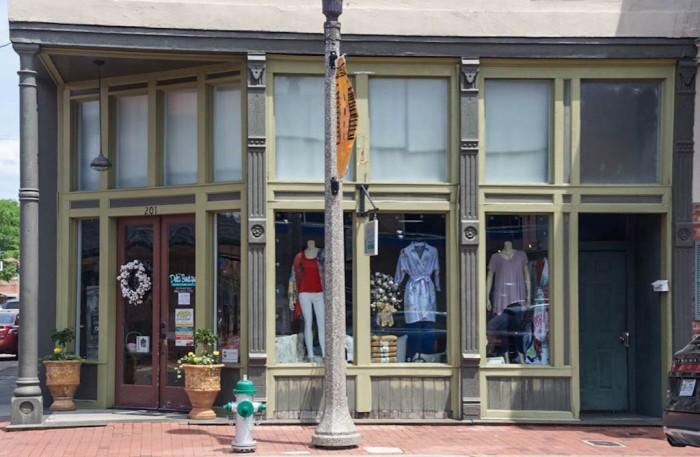
Beautiful–if in need of repair–iron pilasters are also on the former Kitchell aka Midway Hotel.
Can’t get enough ironwork?
Categories: Architectural Research, Greenwood, Historic Preservation







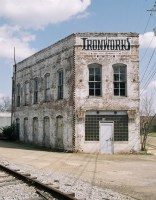

Thank you so much for the photos and research on our downtown pilasters and columns. Because they are such an ingrained part of the architecture, most Greenwood folks never even notice them. This inspires me to photograph and document as many as possible, especially those on the Midway. Its days are numbered. Thank you again for highlighting Greenwood and please let me know when you’ll be back. There are some hidden gems you need to see.
LikeLiked by 1 person
Thank you, and you are welcome. I cannot believe I waited so long to get there, and there is indeed so much more to see. It may be a while before I can get that way again, but I will definitely take you up on the offer. Maybe we could collaborate on a post?
LikeLike
Any time! Just name the subject and I’ll get the photos, historic photos (if available) and research. I just got an external hard drive from Allan Hammons with several thousand Greenwood photos, dating back to 1890s. It is the ultimate time-gobbling rabbit hole for an architecture buff!
LikeLiked by 1 person
I love a good rabbit hole–I spend way too much time in the newspaper archives and the MDAH historic inventory myself.
LikeLike
That upside-down column is bizarre. Haven’t ever seen that before, but on the other hand, maybe I need to start going back through my pictures since I might have thought the same as you, that the imprint was just illegible.
LikeLiked by 1 person
Wouldn’t that be a hoot! We can do a series of upside-down iron pilasters and columns and poles…assuming we find some more that is.
LikeLiked by 1 person
I see cast iron columns by Price-Evans of Chattanooga regularly but almost always in cities served by the Memphis & Charleston Railroad, where (by virtue of Chattanooga being a major city on the line) they seemed to gain a substantial share of the market. Greenwood is a little outside their normal territory.
If someone wanted to get really ambitious, they could map out the distribution of cast iron architectural features and see how the location of various manufacturers’ wares are influenced (or not) by the location of rail lines and/or waterways. I would wager, based on my own experience, that there would be some correlation between where cast iron manufacturers were located (Corinth, Chattanooga, St. Louis, etc.), which railroads ran from those cities (Memphis & Charleston, Mobile & Ohio, etc.), and which cities and towns had which manufacturer’s cast iron.
LikeLiked by 1 person
That certainly seems logical to me–and indeed very ambitious.
LikeLike